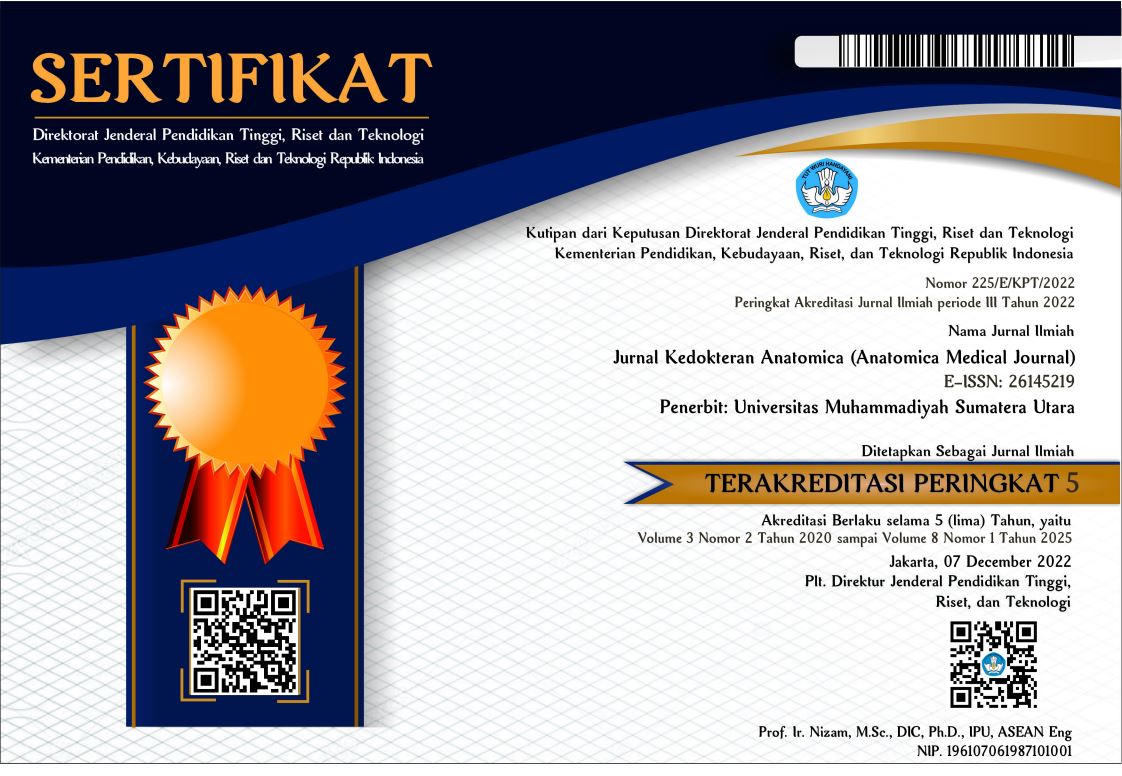Stres Imobilisasi Kronik Mengganggu Memori Spasial Mencit Putih (Mus musculus) Galur Swiss Webster Jantan
Abstract
Long-term exposure to stress may induce structural and functional alterations in the brain and particularly in hippocampus. Several studies have shown that the hippocampus plays an important role in spatial learning and memory. Certain animals can perceive stressors differently depend on stress durations and paradigms. We have designed an investigation to compare the effect of different chronic stress durations, using immobilization tubes, on mice spatial memory ability. Twenty young-adult (10-12 weeks old; 25-35 g) male Swiss Webster mice were randomly assigned into four groups: control (non-stressed) group and groups were exposed to immobilization stress 2 hours/daily (09.00-11.00 am) for 14, 21 and 28 days, respectively. Spatial memory ability was tested by using Morris Water Maze. Data were analyzed with one-way ANOVA (p<0.05). We found that mean escape latency (s) for control, 2h/14 days, 2h/21 days and 2h/28 days groups were 8.49 0.91, 12.40 3.76, 13.73 4.09, and 41.62 21.84, respectively (p<0.05). Post-hoc analysis showed a statistical difference between control and stressed groups (p<0.05), but there was no statistical difference between 2h/21 days and 2h/14 days group (p>0.05). In conclusion, this study showed that chronic immobilization stress had been proven to impair spatial memory ability in mice. Specifically, our findings support the use of 2h/28 days chronic immobilization paradigm as an efficient method to induce spatial memory deficits in mice.
Keywords: immobilization stress, Morris Water Maze, spatial memory
Full Text:
PDFReferences
McEwen, BS. Sentral effects of stress hormones in health and disease: understanding the protective and damaging effects of stress and stress mediators. Eur J Pharmacol. 2008; 583(2-3):174-85.
Kim, JJ, Diamond, DM. The stressed hippocampus, synaptic plasticity and lost memories. Nature Review Neuroscience. 2002; 3:453-62.
Yamada, K, Nabeshima, T. Brain-derived neurotrophic factor/TrkB signaling in memory processes. J Pharmacol Sci. 2003; 91:267-70.
Grnli, J, Bramham, C, Murison, R, Kanhema, T, Fiske, E, Bjorvatn, B, et al. Chronic mild stress inhibits BDNF protein expression and CREB activation in the dentate gyrus but not in the hippocampus proper. Pharmacol Biochem Behav. 2006; 85(4):842-9.
Jeong, JY, Lee, DH, Kang, SS. Effects of chronic restraint stress on body weight, food intake, and hypothalamic gene expressions in mice. Endocrinol Metab. 2013; 28:288-96.
Guyton, AC, Hall, JE. Textbook of medical physiology. 11th ed. Pennsylvania: Elsevier Inc; 2006.
Vorhess, CV, Williams, MT. Morris water maze: procedures for assessing spatial and related forms of learning and memory. Nat Protoc. 2006; 1(2): 848-58 (DOI:10.1038/nprot.2006.116).
Sari, DCR. Pengaruh dosis dan durasi pemberian estrogen terhadap memori spasial pada tikus (Rattus novergicus). Jurnal Kedokteran YARSI. 2001; V(9): 39-55.
McEwen, BS, Sapolsky, RM. Stress and cognitive function. Curr opin neurobiol. 1995; 5:205-16.
McEwen, BS. Stress and hippocampal plasticity. Annu. Rev Neurosci. 1999; 22:105-22.
?ahin, E, Gm?l, S. Alterations in brain antioxidant status, protein oxidation and lipid peroxidation in response to different stress models. Behav Brain Res. 2004; 155(2):241-8.
Bath, KG, Schilit, A, Lee, FS. Stress Effect on BDNF Expression : Effect of Age, Sex, and Form of Stress. Neuroscience. 2013; 239:149-56.
McLaughlin, KJ, Gomeza, JL, Baran, SE, Conrad, CD. The effects of chronic stress on hippocampal morphology and function: an evaluation of chronic restraint paradigms. Brain Research. 2007; 1161:56-64.
Sousa, N, Lucoyanov, NV, Madeira, MD, Almeida, OF, Paula-Barbosa, MM. Reorganization of morphology of hippocampal neurites and synapses after stress-induced damage correlates with behavioral improvement. Neuroscience. 2000; 97(200): 253-66.
Beck, KD, Luine, VN. Food deprivation modulates chronic stress effects on object recognition in male rats: role of monoamines and amino acids. Brain Res. 1999 May 29; 830(10):56-71.
Juananda, D. Pengaruh stres kronik terhadap otak: kajian biomolekuler hormon glukokortikoid dan regulasi brain-derived neurotrophic factor (BDNF). Jurnal Ilmiah Kedokteran. 2015; 9(2):65-70.
Mizuno, M, Yamada, K, Olariu, A, Nawa, H, Nabeshima, T. Involvement of brain-derived neurotrophic factor in spatial memory formation and maintenance in a radial arm maze test in rats. The J of Neurosci. 2000; 20(18): 7116-21.
DOI: https://doi.org/10.30596/anatomica
DOI (PDF): https://doi.org/10.30596/amj.v1i1.1680.g1747
Refbacks
- There are currently no refbacks.
Jurnal Kedokteran Anatomica/ Anatomica Medical Journal (AMJ)
E-mail: amj_fk@umsu.ac.id || Editorial Contact: 081375150018
This work is licensed under aCreative Commons Attribution-ShareAlike 4.0 International License.


.png)
